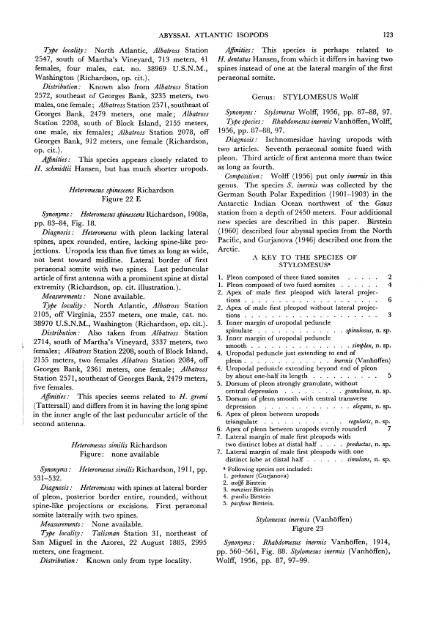The Isopods of Abyssal Depths in the Atlantic Ocean
The Isopods of Abyssal Depths in the Atlantic Ocean
The Isopods of Abyssal Depths in the Atlantic Ocean
You also want an ePaper? Increase the reach of your titles
YUMPU automatically turns print PDFs into web optimized ePapers that Google loves.
Type locality: North <strong>Atlantic</strong>, Albatross Station<br />
2547, south <strong>of</strong> Martha's V<strong>in</strong>eyard, 713 meters, 41<br />
females, four males, cat. no. 38969 U.S.N.M.,<br />
Wash<strong>in</strong>gton (Richardson, op. cit.).<br />
Distribution: Known also from Albatross Station<br />
2572, sou<strong>the</strong>ast <strong>of</strong> Georges Bank, 3235 meters, two<br />
males, one female; Albatross Station 2571, sou<strong>the</strong>ast <strong>of</strong><br />
Georges Bank, 2479 meters, one male; Albatross<br />
Station 2208, south <strong>of</strong> Block Island, 2155 meters,<br />
one male, six females; Albatross Station 2078, <strong>of</strong>f<br />
Georges Bank, 912 meters, one female (Richardson,<br />
op. cit.).<br />
Aff<strong>in</strong>ities: This species appears closely related to<br />
H. schmidtii Hansen, but has much shorter uropods.<br />
Heteromesus sp<strong>in</strong>escens Richardson<br />
Figure 22 E<br />
Synonyms: Heteromesus sp<strong>in</strong>escens Richardson, 1908a,<br />
pp. 83-84, Fig. 18.<br />
Diagnosis: Heteromesus with pleon lack<strong>in</strong>g lateral<br />
sp<strong>in</strong>es, apex rounded, entire, lack<strong>in</strong>g sp<strong>in</strong>e-like projections.<br />
Uropoda less than five times as long as wide,<br />
not bent toward midl<strong>in</strong>e. Lateral border <strong>of</strong> first<br />
peraeonal somite with two sp<strong>in</strong>es. Last peduncular<br />
article <strong>of</strong> first antenna with a prom<strong>in</strong>ent sp<strong>in</strong>e at distal<br />
extremity (Richardson, op. cit. illustration.).<br />
Measurements: None available.<br />
Type locality: North <strong>Atlantic</strong>, Albatross Station<br />
2105, <strong>of</strong>f Virg<strong>in</strong>ia, 2557 meters, one male, cat. no.<br />
38970 U.S.N.M., Wash<strong>in</strong>gton (Richardson, op. cit.).<br />
Distribution: Also taken from Albatross Station<br />
2714, south <strong>of</strong> Martha's V<strong>in</strong>eyard, 3337 meters, two<br />
females; Albatross Station 2208, south <strong>of</strong> Block Island,<br />
2155 meters, two females Albatross Station 2084, <strong>of</strong>f<br />
Georges Bank, 2361 meters, one female; Albatross<br />
Station 2571, sou<strong>the</strong>ast <strong>of</strong> Georges Bank, 2479 meters,<br />
five females.<br />
Aff<strong>in</strong>ities: This species seems related to H. greeni<br />
(Tattersall) and differs from it <strong>in</strong> hav<strong>in</strong>g <strong>the</strong> long sp<strong>in</strong>e<br />
<strong>in</strong> <strong>the</strong> <strong>in</strong>ner angle <strong>of</strong> <strong>the</strong> last peduncular article <strong>of</strong> <strong>the</strong><br />
second antenna.<br />
Heteromesus similis Richardson<br />
Figure: none available<br />
Synonyms: Heteromesus similis Richardson, 1911, pp.<br />
531-532.<br />
Diagnosis: Heteromesus with sp<strong>in</strong>es at lateral border<br />
<strong>of</strong> pleon, posterior border entire, rounded, without<br />
sp<strong>in</strong>e-like projections or excisions. First peraeonal<br />
somite laterally with two sp<strong>in</strong>es.<br />
Measurements: None available.<br />
Type locality: Talisman Station 31, nor<strong>the</strong>ast <strong>of</strong><br />
San Miguel <strong>in</strong> <strong>the</strong> Azores, 22 August 1883, 2995<br />
meters, one fragment.<br />
Distribution: Known only from type locality.<br />
ABYSSAL ATLANTIC ISOPODS 123<br />
Aff<strong>in</strong>ities: This species is perhaps related to<br />
H. dentatus Hansen, from which it differs <strong>in</strong> hav<strong>in</strong>g two<br />
sp<strong>in</strong>es <strong>in</strong>stead <strong>of</strong> one at <strong>the</strong> lateral marg<strong>in</strong> <strong>of</strong> <strong>the</strong> first<br />
peraeonal somite.<br />
Genus: STYLOMESUS Wolff<br />
Synonyms: Stylomesus Wolff, 1956, pp. 87-88, 97.<br />
Type species: Rhabdomesus <strong>in</strong>ermis Vanh<strong>of</strong>fen, Wolff,<br />
1956, pp. 87-88, 97.<br />
Diagnosis: Ischnomesidae hav<strong>in</strong>g uropods with<br />
two articles. Seventh peraeonal somite fused with<br />
pleon. Third article <strong>of</strong> first antenna more than twice<br />
as long as fourth.<br />
Composition: Wolff (1956) put only <strong>in</strong>ermis <strong>in</strong> this<br />
genus. <strong>The</strong> species S. <strong>in</strong>ermis was collected by <strong>the</strong><br />
German South Polar Expedition (1901-1903) <strong>in</strong> <strong>the</strong><br />
Antarctic Indian <strong>Ocean</strong> northwest <strong>of</strong> <strong>the</strong> Gauss<br />
station from a depth <strong>of</strong> 2450 meters. Four additional<br />
new species are described <strong>in</strong> this paper. Birste<strong>in</strong><br />
(1960) described four abyssal species from <strong>the</strong> North<br />
Pacific, and Gurjanova (1946) described one from <strong>the</strong><br />
Arctic.<br />
A KEY TO THE SPECIES OF<br />
STYLOMESUS a<br />
1. Pleon composed <strong>of</strong> three fused somites 2<br />
1. Pleon composed <strong>of</strong> two fused somites 4<br />
2. Apex <strong>of</strong> male first pleopod with lateral projections<br />
6<br />
2. Apex <strong>of</strong> male first pleopod without lateral projections<br />
3<br />
3. Inner marg<strong>in</strong> <strong>of</strong> uropodal peduncle<br />
sp<strong>in</strong>ulate sp<strong>in</strong>ulosus, n. sp.<br />
3. Inner marg<strong>in</strong> <strong>of</strong> uropodal peduncle<br />
smooth simplex, n. sp.<br />
4. Uropodal peduncle just extend<strong>in</strong>g to end <strong>of</strong><br />
pleon <strong>in</strong>ermis (Vanh<strong>of</strong>fen)<br />
4. Uropodal peduncle extend<strong>in</strong>g beyond end <strong>of</strong> pleon<br />
by about one-half its length 5<br />
5. Dorsum <strong>of</strong> pleon strongly granulate, without<br />
central depression granulosus, n. sp.<br />
5. Dorsum <strong>of</strong> pleon smooth with central transverse<br />
depression elegans, n. sp.<br />
6. Apex <strong>of</strong> pleon between uropods<br />
triangulate regularis, n. sp.<br />
6. Apex <strong>of</strong> pleon between uropods evenly rounded 7<br />
7. Lateral marg<strong>in</strong> <strong>of</strong> male first pleopods with<br />
two dist<strong>in</strong>ct lobes at distal half . . . . productus, n. sp.<br />
7. Lateral marg<strong>in</strong> <strong>of</strong> male first pleopods with one<br />
dist<strong>in</strong>ct lobe at distal half simulans, n. sp.<br />
a Follow<strong>in</strong>g species not <strong>in</strong>cluded:<br />
1. gorbunovi (Gurjanova)<br />
2. wolffi Birste<strong>in</strong><br />
3. menziesi Birste<strong>in</strong><br />
4. gracilis Birste<strong>in</strong><br />
5. pacificus Birste<strong>in</strong>.<br />
Stylomesus <strong>in</strong>ermis (Vanh<strong>of</strong>fen)<br />
Figure 23<br />
Synonyms: Rhabdomesus <strong>in</strong>ermis Vanh<strong>of</strong>fen, 1914,<br />
pp. 560-561, Fig. 88. Stylomesus <strong>in</strong>ermis (Vanh<strong>of</strong>fen),<br />
Wolff, 1956, pp. 87, 97-99.

















